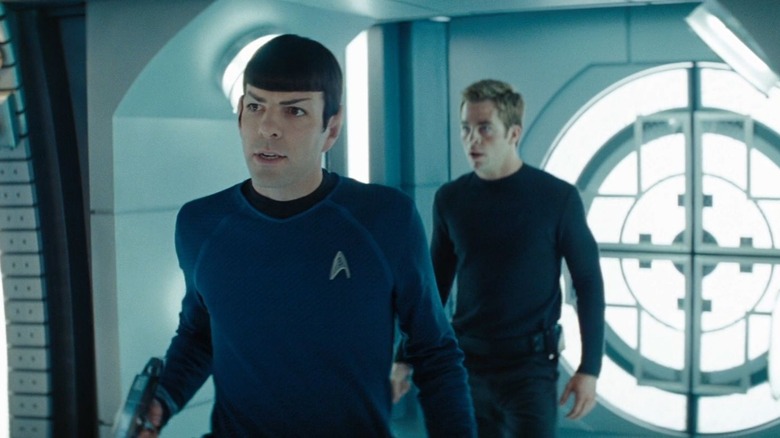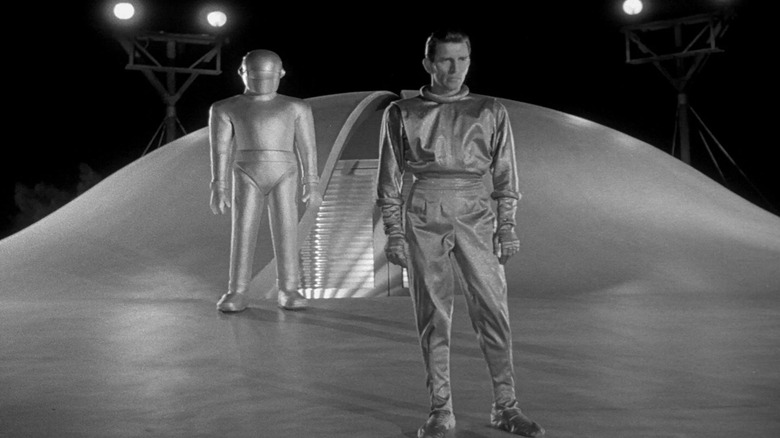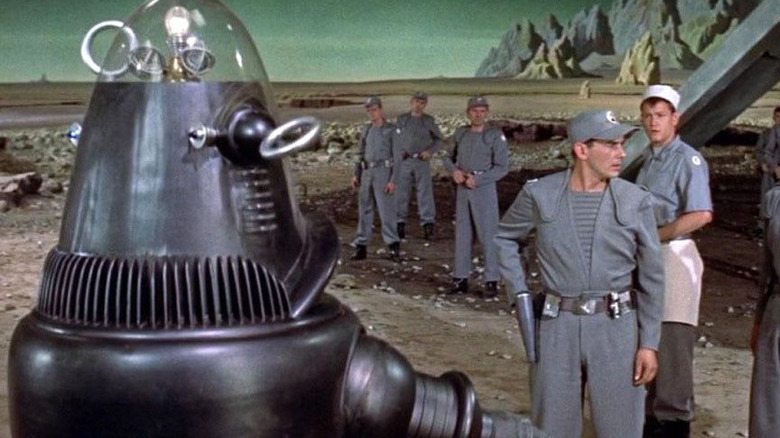The Look Of J.J. Abrams' Star Trek Came From Two Classic '50s Sci-Fi Films
The Starfleet uniforms seen on the original "Star Trek" in 1966 were, as military uniforms go, pretty minimalist. They were solid colors, and only bore small golden accents to indicate rank and to display the famous Starfleet delta-shaped insignia. The shirts worn by the male officers had black collars, some uncomfortable-looking slacks, and fashionable 1960s shoes. The dresses for women were tailored and short, worn with black leggings and higher-heeled shoes. They were more fashionable — and sexist — than the minimalist male uniforms. On "Star Trek: The Next Generation," male officers were seen in the minidresses throughout the first season, but the dresses remained notorious.
Weirdly, "Star Trek" uniforms weren't particularly futuristic. They didn't look like traditional space suits worn by astronauts. They were merely the colors worn by a 23rd-century space military. Functional more than comfortable.
When J.J. Abrams rebooted "Star Trek" in 2009, he shifted the action into an alternate timeline wherein familiar characters were now played by new actors, and everything looked a little ... different. The ships were different, the Enterprise's bridge was different, and the uniforms were made slicker and more "sci-fi." The colors were altered, having been stippled with miniature Starfleet deltas, giving the uniforms a more dynamic visual texture. The black collars were now no longer part of the tunic or minidress, but a separate dark undershirt.
In the oral history book "The Fifty-Year Mission: The Next 25 Years: From The Next Generation to J. J. Abrams," edited by Mark A. Altman and Edward Gross, "Star Trek" costume designer Michael Kaplan noted that his designs, more than "Star Trek," were inspired by older sci-fi classics, particularly 1951's "The Day the Earth Stood Still" and 1961's "Forbidden Planet."
'That retro futuristic feeling'
Abrams, in various interviews, frequently noted that he wasn't a Trekkie and that he never "got" "Star Trek." He was always more of a "Star Wars" guy, which may go a long way to explain why the 2009 "Star Trek" movie is so action-packed and fiery, instead of cerebral and philosophical. Kaplan noted that he, too, was no Trekkie, and that Abrams admired that about him. They both seemed to feel that their outsider perspective would be creatively beneficial and that their sci-fi influences would be older and more varied than the singular universe of Trek.
Notably, Kaplan had to design uniforms for two different "Star Trek" eras. The first era took place on board the U.S.S. Kelvin, right when James T. Kirk was born, while the bulk of the picture took place when Kirk was in his early 20s. For the "present day," Kaplan figured he could extrapolate a modern version of the 1960s uniforms. For the "past" portions, however, Kaplan felt that borrowing from sci-fi that existed prior to "Star Trek" was appropriate. He said:
"I wanted to have a different flavor and a different look on the Kelvin. I looked back into 1950's sci-fi films like 'The Day the Earth Stood Still' and 'Forbidden Planet' and kind of wanted to take that retro futuristic feeling and infuse it. J.J. was very happy with that look. That's the kind of research I did, certainly not copying any of those but trying to get that kind of retro flavor so that when you saw it, subconsciously you'd know you were in an earlier world."
The U.S.S. Kelvin was the ship piloted (briefly) by Kirk's father (Chris Hemsworth), and one can see the "Forbidden Planet" influence in his tunic.
Silver jumpsuits and black leather belts
In the picture above, one can see the uniforms from "Forbidden Planet," designed by Walter Plunkett. Incidentally, those uniforms would crop up in other sci-fi films afterward, notably "Queen of Outer Space" starring Zsa-Zsa Gabor. The grey color, black leather belt, and over-the-shoulder piping of Plunkett's designs made their way onto Hemsworth's torso in 2009.
Kaplan noted that, while not a Trekkie, remaining within a 1960s sci-fi aesthetic was important. He said:
"There's a sixties sensibility I thought was important to keep intact. It was really about finding a balance. I would do some sketching and say, 'I love this costume idea, but it doesn't feel like 'Star Trek,” and we would abandon it. A design could have been more 'Star Wars,' for example. There's a vocabulary that was needed and, of course, I studied 'The Star Trek Encyclopedia.'"
To Kaplan's credit, there are no uniforms or costumes in "Star Trek" that give off the unique brand of "1970s pinball machine" given off by the earlier "Star Wars" movies.
Kaplan also noted that he was inspired by the alien costume in "The Day the Earth Stood Still," designed by Perkins Bailey. Curiously, this was Bailey's only film credit. The uniform worn by the alien Klaatu (Michael Rennie) was a glittery silver jumpsuit with a high waist and a puffy collar and cuffs. The cut and texture of the alien clothes are very much based on the styles of the 1950s, and feel far too retro for modern audiences to accept as "sleek" or "futuristic." Perhaps Kaplan merely liked the dignity of the Klaatu character and wanted to subtly use fashion to emulate his diplomatic intelligence.


